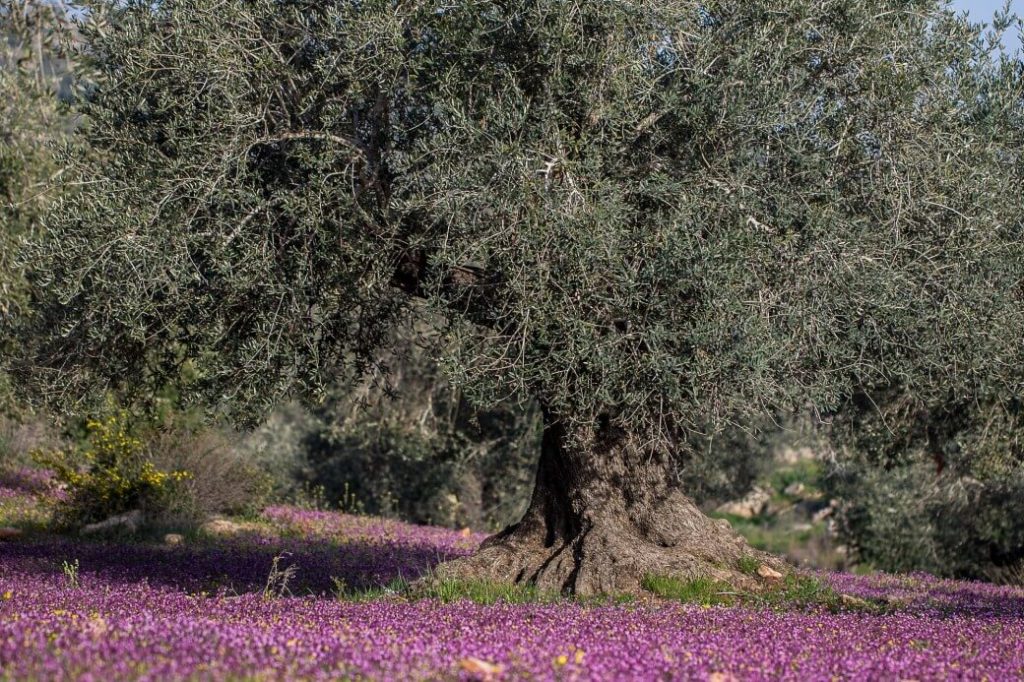From recent BirdLife International newsletter.
From vibrant flower carpets amongst ancient olive trees, to small, encroached patches of purple petals on hillsides, Palestine’s plants are special. And now there’s a growing movement to protect them – one that combines the enthusiasm of emerging young plant conservationists and the wisdom of traditional knowledge.
Palestine is special. So too it is with its plant species. In terms of Palestine’s natural terrain, it sits at the nexus of three major ecoregions, which has given rise to a great diversity of wildlife – over 2000 plant species in fact, 54 of which are endemic. And in terms of Palestine’s geography, it’s surrounded by sea and fences and encroached by human development – much like its endemic plants, which are restricted to small, narrowing, degraded habitat with specific requirements.

© Ahmad Al Omari
For the first time, BirdLife (through its role as Regional Implementation Team for the Mediterranean Hotspot of the Critical Ecosystem Partnership Fund (CEPF)) has provided small grants to five civil society organisations in Palestine, to conserve threatened and site-restricted endemic plants and their habitats. Through these projects, the botanical knowledge and skills of scientists, and conservationists will be strengthened, and hopefully passed down like the ancient farming knowledge held within its olive groves.
On the hills above the famous ‘most fertile meadow’ in the Middle East, Marj Ibn Amer, a beautiful flower Iris haynei grows. Found nowhere else in the world except Faquaa village, Palestine, this rare endemic iris hangs on in patchy and fragmented populations and is considered globally threatened. In 2015, Iris haynei was declared the national plant of the State of Palestine by Palestinian Environment Quality Authority. Together with the Palestine Wildlife Society (PWLS, a BirdLife partner), they are making exceptional efforts to save it with support from CEPF. Findings so far are encouraging, with major engagement of youth from local communities around the village to contribute on the efforts to save the iris – which faces many threats including overgrazing, pests, localised flower collection, afforestation and development.
In Misilyah village, in the north of the West Bank, stand ancient groves of gnarled olive trees surrounded by a vibrant carpet of delicate flowers that, until recently, had never been studied. Some trees are over 800 years old, passed down from generation to generation along with the traditional knowledge of how to care for them, and are considered by Palestinians as a symbolic attachment to their land. It’s their agricultural practices – such as organic composting, crop rotation and intercropping – that have allowed the remarkable flora to thrive, according to recent research by the An-najah National University.
Elsewhere, when conservationist Dr Anton Khalilieh came upon a rare flower in bloom in the North Eastern Slopes of Palestine (a Key Biodiversity Area, KBA), he immediately video-called his colleague. “This is paradise,” he said, moving his phone from left to right to show the beautiful scenery filled with many patches of another iris, Iris atrofusca. “We have to do something about it.” Although the elegant, rich purple flowers were scattered throughout this area, the challenges threatening their existence are persistent. Found almost exclusively within Palestine, their fragile population cannot withstand further degradation, habitat loss and exploitation by people.
Dr Khalileh is the Executive Director of Nature Palestine Society (NPS), a three-year-old NGO aiming to research, conserve, and educate about biodiversity and the environment in Palestine that has received a CEPF grant for their work. Very little was known about Iris atrofusca in Palestine, so a survey was needed. The NPS team wandered around 1400 hectares and, surprisingly, discovered an area of about 180 hectares that contained over 7800 iris flowers. Two rare colour variations – yellow and white – were also found nestled within.
During the survey, the team met a shepherd wandering with his 300 sheep and cows, who had fallen in love with the iris after he noticed that his sheep did not eat it. He worked hard to conserve it in the wild and helped the team to figure out its distribution. A botanical garden for the iris was established as an in-situ conservation site on 0.5 hectares, out of 1.4 hectares donated by the Ministry of Agriculture and the Environment Quality Authority within the KBA. Here, 120 clones of Iris atrofusca were planted in 2021.
